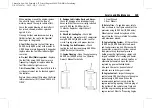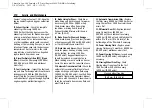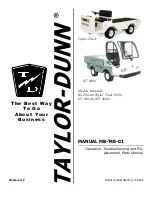
Chevrolet Low Cab Forward 6.7L Diesel Engine 6500XD (GMNA-Localizing-
U.S.-15749874) - 2022 - CRC - 12/1/21
Service and Maintenance
281
Additional Maintenance
and Care
Owner Safety and Routine Maintenance
Listed below are vehicle checks which should
be made periodically by either the owner or
a qualified technician to ensure proper
performance and safety of your vehicle.
Take any problems promptly to a technician
for service advice.
For your safety and that of others, any of
the safety-related components that may
have been damaged in a crash should be
checked and necessary repairs performed
before operating your vehicle.
At a minimum, these routine checks should
be made every 6 months or 16,000 km
(10,000 miles), whichever comes first.
Whenever repairs are necessary, have them
completed before operating the vehicle.
A: Parking Brake :
Park on a fairly steep hill
and hold the vehicle with the parking brake
only. This checks holding ability.
Before checking item (B) below, be sure to
have enough room around the vehicle. Then
firmly apply both the parking brake see
and the regular brakes.
Do not use the accelerator pedal. If the
engine starts, be ready to turn off the
engine control switch at once. Take these
precautions because the vehicle could move
without warning and possibly cause injury
or property damage.
B: Starter Safety Switch :
Check by trying to
start the engine in each gear. The starter
should crank only at selector position "P"
(only models with P-range) or "N".
C: Transmission Shift Indicator :
Check that
the indicator points to the gear chosen.
D: Steering :
Be alert for any changes in
steering action. An inspection or service is
needed when: the steering wheel is harder
to turn or has too much free play, or when
there are strange sounds when turning or
parking.
E: Wheel Alignment, Balance, and Tires :
Check tires for abnormal wear or damage.
Also, check for damaged wheels. A pull right
or left on a straight and level road may
show the need for a wheel alignment.
A vibration of the steering wheel or seat at
normal highway speeds may mean a wheel
balancing is needed. Check tire pressure
when the tires are "cold," at least monthly,
and whenever the vehicle is serviced.
Check the pressure more often if daily
checks show it's needed. (Refer to
"Recommended Daily (Pre-operation)
Inspections" under
). Change tire pressure as
needed when changing loads.
F: Brakes :
Be alert to illumination of the
brake air pressure warning light or the
buzzer, or changes in braking action, such as
repeated pulling to one side, unusual sounds
when braking, increased brake pedal travel
or a harder pedal. The front and rear brakes
are attached to an auto adjuster mechanism.
If there are no defects, and the brake stroke
is properly maintained, adjustments are not
necessary.
The automatic slack adjuster should
maintain the brake chamber stroke at
2 inches or less. Brake chamber stroke is the
distance the push rod travels from brakes
off to brakes applied. If the orange brake
chamber stroke indicator on the push rod is
visible outside the brake chamber, the stroke
is greater than 2 inches and the brakes
should be Inspected. Have your dealer
inspect the automatic slack adjuster for
correct operation and set up.









































